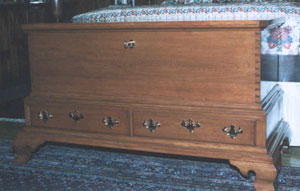
A trip to Colonial Williamsburg in 1968 was a life changing experience for Gerry Mayberry. There he saw furniture from the William and Mary period, Queen Anne, Georgian, and Chippendale; all the great designs found in the best colonial homes. The distinctive cabriole of the Queen Anne period especially caught his eye. It took time, but some 35 years later, Gerry is a master of these classic styles. His work has been showcased in Fine Woodworking and featured most recently in a Shop Shots at Wood Central.
Now retired – having put in 32 years as a chemist at Kodak’s plant in Kingsport, Tennessee — Gerry has a shop full of tools and plenty of time for projects he builds for his family. Back when he started, though, all Gerry had was a radial arm saw.
“With not much in the way of tools, I started out making clocks,” Gerry recalled. “I got plans from a company called Mason and Sullivan for school clocks. That was kind of an introduction for me to woodworking.”
But after his trip to Williamsburg, Gerry decided he needed to increase his skill level. With only a few books and magazine articles available in those early days, Gerry took a methodical approach.
“I was trained to do research, and I did lots of reading and made lots of attempts to do some of the stuff I read about. It took a lot of practice, but gradually I had some success.” Gerry explained, “But I was always trying to push harder, to find a project that would push my skill another notch up. I thought that if one day I could make beautiful furniture, it would be wonderful.”
A handyman magazine provided a few plans, and he found books on traditional English hand woodworking. But, like for so many others, the appearance of Fine Woodworking in 1976 changed everything for Gerry [Woodworker’s Journal appeared just a few months later – Editor].
“It was the first magazine with lots of techniques. And then people started writing books on techniques. I did more reading on period furniture and began in a simple way to attempt to build some of those things. It gradually came together & like cutting dovetails. My attempts were pretty crude, but I kept hacking away and followed the advice from Tage Frid’s books.”
By that time, Gerry felt that his interest in woodworking was going to be sustained and decided to add a shop onto his house and invest in some good tools. And one day he brought home a new kind of tool.
“It was a router, an early Sears model. My wife asked what was I going to do with it. I told her I didn’t know, but was going to find out. There weren’t many bits in those days, and they were just high-speed steel and would get dull fairly quickly. But you could cut grooves and put a quarter round on the edge of pieces of wood or molding. Then along came ideas for simple router tables, and I built one. Eventually, the router made a huge difference.”
Over the years, Gerry invested in a Delta Unisaw, a 6″ jointer (replaced five years ago by a 8″ model), a Powermatic 12″ planer, a shaper, a Delta lathe, an 18″ Hagner jigsaw, and he still has that old radial arm saw.
Though most don’t share his passion for period furniture, he shares ideas and techniques with woodworking friends in the area. But books and magazines have remained an important influence on Gerry. A few years back, he spotted a chair he liked in an antiques magazine article on Mount Vernon furniture. With only the picture to start with, Gerry set out to make a set of them for his dining room.
“I found a drawing of a similar chair in Franklin H. Gottshall’s book “Making Furniture Masterpieces” that gave me some dimensions and ideas on how to deal with all the mortise and tenon angles. But I didn’t like the ribbon back on his chair and changed it to a pretzel back.” Gerry explained, “But the big thing about making chairs is you’ve got to get the doggone thing where it’s comfortable. It was the first chair I ever built, so I made a prototype first, and I found that one of the rails that goes across the back actually struck you in the wrong place in your back. It wasn’t terribly uncomfortable, but enough where I felt it. The mechanical drawing classes I had in high school and college helped me modify the design and create templates for the pierced cutouts on the pretzel backs.”
Gerry is fit at 69 years old because he takes pretty good care of himself, running three miles several times a week and lifting weights. Over time, he estimates, he’s made 80 or 90 pieces of furniture & lots of chairs; plus lowboys, some with cabriole legs and some with William and Mary trumpet turned legs; a sewing center for his wife, which is a cabinet over a set of drawers, ; and many other projects. Nowadays, most of Gerry’s projects are for his children’s families & and not just in Williamsburg styles.
“I recently built my daughter a large chest on chest, and I’m just now finishing a Shaker piece for my son,” Gerry noted. “It’s kind of a pantry for his kitchen, and this has a nice molding at the top, distinctive to the Shakers in Watervliet, New York.”
Still the Williamsburg influence runs deep. At a recent carving class, Gerry happened to mention what a profound experience going to Williamsburg had been for him. He was surprised when a retired Harvard lawyer said exactly the same thing, and then several other retired class members noted that their trips to Williamsburg had also inspired their love of period furniture.







